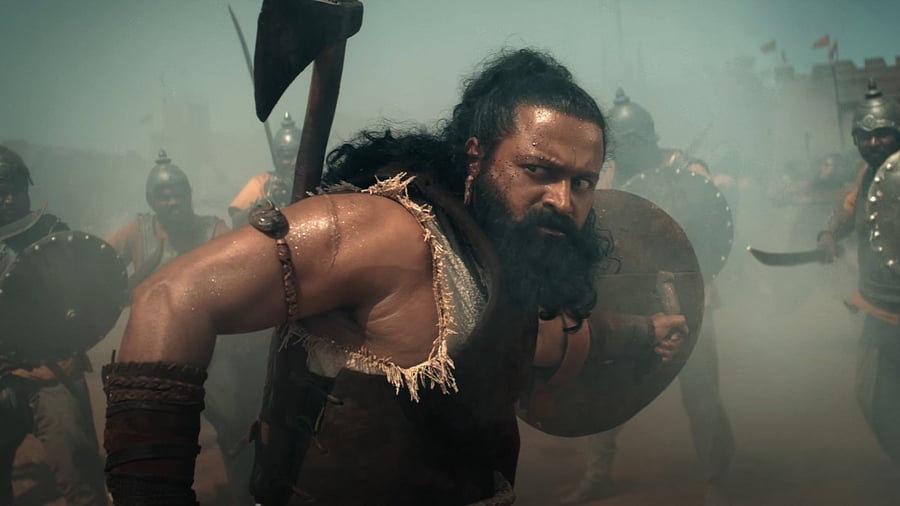
Rishab Shetty in Kantara Chapter 1.
Credit: Hombale Films
One of the first thoughts that comes to mind while watching ‘Kantara: The Legend – Chapter 1’ is that it is nothing but ‘Kantara’ with a bigger budget and a different timeline.
Billed as a prequel to ‘Kantara’, released in 2022, ‘Chapter 1’ is set in 4th century India during the reign of the Kadambas. An evil king sets his eyes on Eeswarana hoodota (Shiva’s garden) in Kantara, a mystical forest. A Guliga (a guardian spirit) comes to the rescue of the forest and its tribal community by killing the king. His son Rajashekara (Jayaram) is then saved by a tribe from Kadaba dikku, who also have their eyes on the mystical powers of Kantara. Rajashekara stays away from Kantara, but a few years later, his son, Kulashekara (Gulshan Devaiah), returns. His conflict with Berme (Rishab Shetty), protector of the tribe and Kantara, sets things in motion revealing the many secrets of the forest and the kingdom.
Like ‘Kantara’, the prequel doesn’t follow the three-act structure, so it doesn’t take off until after the interval. It takes its own time in constructing its mythical world, where everything, including the tribal settlements and the market place, look shiny new (making the sets look largely superficial!).
For a film with at least three to four fight scenes, and mind-boggling twists, the narrative fails to build enough suspense for the climax. The writing picks up here and there, but falls flat otherwise. While the last 30 minutes in ‘Kantara’ piqued the interest of the audience, the prequel only offers a weakly written climax and a repeat of the ‘Varaha roopam’ theme (where a deity intervenes to render justice).
It looks like Ajaneesh Loknath has only rehashed the background score from the first part. And to play it continuously for close to three hours is unpardonable! In addition to some good shots, the action scenes and the VFX stand out.
Rukmini Vasanth’s character adds more than just glamour to the screen, becoming an integral part of the narrative. And though Rishab’s character is not convincing, he is compelling and enjoys a great screen presence.
‘Chapter 1’ aims to trace the origins of Bhoota Kola, a ritual shown in the 2022 film. However, it ends up furthering the agenda of the first film with a legendary tale.
In ‘Kantara’, Panjurli, or the boar deity worshipped in the Tulu-speaking regions of coastal Karnataka, was addressed as Varaha (an avatar of Vishnu), in the process Brahminising a non-Brahmanical practice. In ‘Chapter 1’, the folk daivas are called ganas (attendants of Shiva) sent by Shiva. This goes against the belief of the people who worship the daivas in Tulunadu. What is ironic is that, even as the tribal community wins against the kings, a competing cosmology is reinforced. The makers attribute the creation of the land to Parashurama, the sixth avatar of Vishnu (as believed by the Brahmins), as opposed to the belief of the non-Brahmins, folk and tribal communities — who believe Bermer, the eldest or the head of all daivas, created the land. This, even as the protagonist goes by the name of Berme. Is the film appropriating tribal beliefs and gods for the cause of an overarching religious identity?
One of the critical problems in ‘Kantara’ was the use of divine intervention to address problems such as the official appropriation of commonly held tribal land. ‘Chapter 1’ is no different. In fact, to empower one tribe, it presents another tribe as the antagonist.
By the end of the film, you wonder if it is really about man vs nature!